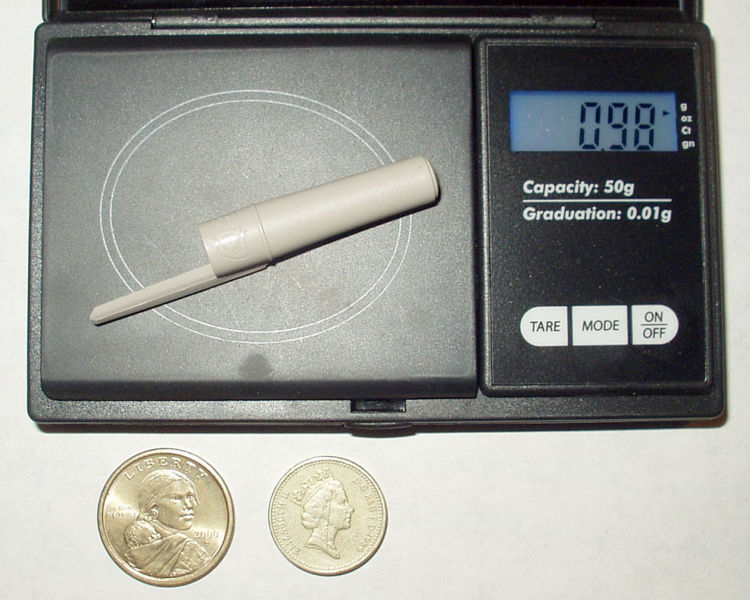Gram

|
WikiDoc Resources for Gram |
|
Articles |
|---|
|
Media |
|
Evidence Based Medicine |
|
Clinical Trials |
|
Ongoing Trials on Gram at Clinical Trials.gov Clinical Trials on Gram at Google
|
|
Guidelines / Policies / Govt |
|
US National Guidelines Clearinghouse on Gram
|
|
Books |
|
News |
|
Commentary |
|
Definitions |
|
Patient Resources / Community |
|
Directions to Hospitals Treating Gram Risk calculators and risk factors for Gram
|
|
Healthcare Provider Resources |
|
Continuing Medical Education (CME) |
|
International |
|
|
|
Business |
|
Experimental / Informatics |
Editor-In-Chief: C. Michael Gibson, M.S., M.D. [1]
The gram (sometimes gramme in British English, although gram prevails), (Greek/Latin root grámma); symbol g, is a unit of mass.
Originally defined as "the absolute weight of a volume of pure water equal to the cube of the hundredth part of a metre, and at the temperature of melting ice"[1] (later 4 °C), a gram is now defined as one one-thousandth of the SI base unit, the kilogram, or 1×10-3 kg, which itself is defined as being equal to the mass of a physical prototype preserved by the International Bureau of Weights and Measures.
Examples
All masses are approximate:
- Plastic pen cap (Bic): 1 gram
- A single Smartie: 1 gram
- Paper clip: 0.5 grams to 1.5 grams
- 1 US banknote (any denomination): 1 gram[2]
- 1 litre of air: 1.2 grams
- A teaspoon of salt: 4.745 grams
- Typical sheet of A4 paper: 5 grams (if 80 g/m²)
- United States nickel: 5 grams (very accurate when new)[3]
Other abbreviations
The International System of Units abbreviation for the gram is g, and follows the numeric value with a space, as in "200 g"[4][5]. In some fields and regions, the international standard symbols for units are used quite strictly, in particular in technical and scientific publications and in legally regulated product labels. In other contexts (e.g., grocery market traders), a wide range of other abbreviations can also be encountered, such as gr, gm, grm, gms, grms.
History
It was the base unit of mass in the original French metric system and the later centimetre-gram-second (CGS) system of units. The word originates from late Latin gramma – a small weight.
Uses
The gram is today the most widely used unit of measurement for non-liquid ingredients in cooking and grocery shopping worldwide. For food products that are typically sold in quantities far less than 1 kg, the unit price is normally given per 100 g.
Most standards and legal requirements for nutrition labels on food products require relative contents to be stated per 100 g of the product, such that the resulting figure can also be read as a percentage.
SI multiples
Because SI prefixes may not be concatenated (serially linked) within the name or symbol for a unit of measure, SI prefixes are used with the gram, not the kilogram, which already has a prefix as part of its name.[6] For instance, one-millionth of a kilogram is 1 mg (one milligram), not 1 µkg (one microkilogram).
- When the Greek lowercase “µ” (mu) in the symbol of microgram is typographically unavailable, it is occasionally—although not properly—replaced by Latin lowercase “u”.
- The microgram is often abbreviated “mcg”, particularly in pharmaceutical and nutritional supplement labeling, to avoid confusion since the “µ” prefix is not well recognized outside of technical disciplines.[7] Note however, that the abbreviation “mcg”, is also the symbol for an obsolete CGS unit of measure known as the “millicentigram,” which is equal to 10 µg.
- The unit name “megagram” is rarely used, and even then, typically only in technical fields in contexts where especially rigorous consistency with the units of measure is desired. For most purposes, the term “tonne,” or “metric ton” is instead used. Further, whereas unit name “megatonne” or “megaton” (Mt) is often used in popular literature on global climate change, the equivalent value in scientific literature on the subject is the “teragram” (Tg).
Conversion factors
- 1 grain = 0.06479891 gram
- 1 ounce (avoirdupois) = 28.349523125 grams
- 1 ounce (troy) = 31.1034768 grams
References
- ↑ Décret relatif aux poids et aux mesures, 1795
- ↑ Bureau of Engraving and Printing
- ↑ The United States Mint Coin Specifications
- ↑ SI brochure, Section 3.2
- ↑ NIST Special Publication 811
- ↑ NIST: SI prefixes (link to Web site).
- ↑ The practice of using the abbreviation “mcg” rather than the SI symbol “µg” was formally mandated for medical practitioners in 2004 by the Joint Commission on Accreditation of Healthcare Organizations (JCAHO) in their “Do Not Use” List: Abbreviations, Acronyms, and Symbols because hand-written expressions of “µg” can be confused with “mg”, resulting in a thousand-fold overdosing. The mandate was also adopted by the Institute for Safe Medication Practices.
See also
External links
ar:جرام ast:Gramu be:Грам bg:Грам ca:Gram da:Gram (enhed) de:Gramm et:Gramm el:Γραμμάριο eo:Gramo fa:گرم ko:그램 hi:ग्राम it:Grammo ku:Gram lt:Gramas hu:Gramm nl:Gram (eenheid) no:Gram nn:Gram nrm:Granme simple:Gram sk:Gram sl:Gram sv:Gram th:กรัม uk:Грам ur:گرام yi:גראם (מאס) zh-yue:克